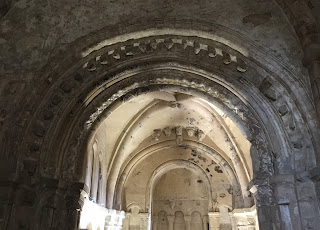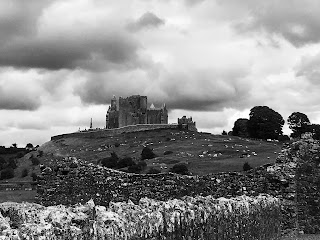As I wind down my sojourn here in Ireland, I had been thinking of the places I hadn't yet visited. One place that is fairly close to us is the Rock of Cashel.
It is this massive, castle-like ruin on top of, well, a huge rock in Tipperary. The traditional seat of the Kings of Munster, there is also a legend about St. Patrick and the Devil--one of the many! It is about an hour and a half's drive from here and a hugely popular tourist attraction. Which is why I avoided it until the end of August. But Sheila's visit from England was a great opportunity to go and on this mostly sunny day I drove over, stopping briefly at a favorite breakfast stop, Dove Hill just outside of Carraig-on-Suir.
The Rock certainly didn't disappoint. Much like Edinburgh Castle it looms over the small town of Cashel. You see it as soon as you turn down the road into the town. And then it disappears from view, you park your car and trudge up a winding road and, voila, there it is again.


It is this massive, castle-like ruin on top of, well, a huge rock in Tipperary. The traditional seat of the Kings of Munster, there is also a legend about St. Patrick and the Devil--one of the many! It is about an hour and a half's drive from here and a hugely popular tourist attraction. Which is why I avoided it until the end of August. But Sheila's visit from England was a great opportunity to go and on this mostly sunny day I drove over, stopping briefly at a favorite breakfast stop, Dove Hill just outside of Carraig-on-Suir.
The Rock certainly didn't disappoint. Much like Edinburgh Castle it looms over the small town of Cashel. You see it as soon as you turn down the road into the town. And then it disappears from view, you park your car and trudge up a winding road and, voila, there it is again.
Despite the day being relatively fine (for Ireland), there really weren't that many tourists around. Which made exploring the site very pleasant. We opted to join a guided tour so that we could get the full story about the Rock. That was great because the guide did indeed tell us loads of interesting things about it. The oldest building, the round tower, was built around 1100 and donated by the High King of Munster, Murtough O'Brien, great grandson of the famous Brian Boru, to the Church at the time. The guide said it was because, really, the place was way too damp and drafty even for a king of Ireland.
The beautiful Cormac's Chapel was built between 1127 and 1134. It has vaulted ceilings and amazing arches and the remains of some beautiful frescoes. Sadly the frescoes are degrading despite efforts to preserve them. It is just too. . .damp.
I am so glad that I saw this in "real life." Photos really can't capture the feeling and beauty of the Chapel.
And then there was the graveyard. I confess that I lost interest in what the guide was saying and started focusing on the inscriptions. I took about 30 photos to add to our website. The graveyard is soon be closed to further burials--they took a kind of census of people who had the right (because of previous generations being buried there) to be interred in I think 1930 (or was it 1950?). And there are only 3 people still living who are on that list. So it's full and it is too difficult to bury in the "rock" anyway.
 |
| The top of this Scully monument was broken off by lightning in 1977 |
We visited the Vicars Choral building before we left. Magnificent tapestry inside.

When we were on the Rock, we could see the ruins of Hore Abbey below. After a sandwich at a pub in Cashel, we went to Hore. It is a "typical" (i.e., what I have seen several of in Ireland) ruined Abbey but the view from Hore to the Rock was beautiful. Amazing to think of monks in the Abbey looking up at the Rock. And processing between the two perhaps.

























Comments
Post a Comment